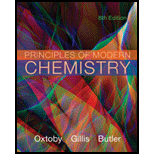
Concept explainers
Interpretation: Whether
Concept introduction: Two or more than two atomic orbitals overlap to form bond, these orbitals are called molecular orbitals. Count of molecular orbital obtained is same as count of atomic orbitals mixed.
Two forms of molecular orbital are obtained. These are bonding and antibonding orbital.
Bonding orbitals are those in that electrons are in between nucleus of two atom. Antibonding orbitals are those in which electrons are away from nucleus of two-atom. Also, electrons in antibonding orbital have energy high as compared to bonding orbital.
In sigma
In pi
In pi
Want to see the full answer?
Check out a sample textbook solution
Chapter 6 Solutions
Bundle: Principles of Modern Chemistry, 8th + OWLv2, 1 term (6 months) Printed Access Card
- Write reasonable Lewis structures for the following species, none of which follow the octet rule. (a) BF3 (b) NO (c) CO+ (d) ClO3arrow_forwardBond Enthalpy When atoms of the hypothetical element X are placed together, they rapidly undergo reaction to form the X2 molecule: X(g)+X(g)X2(g) a Would you predict that this reaction is exothermic or endothermic? Explain. b Is the bond enthalpy of X2 a positive or a negative quantity? Why? c Suppose H for the reaction is 500 kJ/mol. Estimate the bond enthalpy of the X2 molecule. d Another hypothetical molecular compound, Y2(g), has a bond enthalpy of 750 kJ/mol, and the molecular compound XY(g) has a bond enthalpy of 1500 kJ/mol. Using bond enthalpy information, calculate H for the following reaction. X2(g)+Y2(g)2XY(g) e Given the following information, as well as the information previously presented, predict whether or not the hypothetical ionic compound AX is likely to form. In this compound, A forms the A+ cation, and X forms the X anion. Be sure to justify your answer. Reaction: A(g)+12X2(g)AX(s)The first ionization energy of A(g) is 400 kJ/mol. The electron affinity of X(g) is 525 kJ/mol. The lattice energy of AX(s) is 100 kJ/mol. f If you predicted that no ionic compound would form from the reaction in Part e, what minimum amount of AX(s) lattice energy might lead to compound formation?arrow_forwardWhich of these molecules is least likely to exist: NF5, PF5, SbF5, or IF5? Explain why.arrow_forward
- In which of the following molecules does the sulfur have an expanded octet? For those that do, write the Lewis structure. (a) SO2 (b) SF4 (c) SO2Cl2 (d) SF6arrow_forwardUsing the bond dissociation enthalpies in Table 8.8, estimate the enthalpy of combustion of gaseous methane, CH4, to give water vapor and carbon dioxide gas.arrow_forwardBased on average bond enthalpies, would you expect a photon capable ofdissociating a C¬Cl bond to have sufficient energy to dissociate a C¬Br bond?arrow_forward
- The compounds ethyne, ethene and ethane contain, respectively, C≡C, C=C and C–C bonds. What is the expected sequence of carbon–carbon bond lengths and bond enthalpies. Select one: a. Bond lengths: C≡C > C=C > C–C; bond enthalpies: C≡C < C=C < C–C b. Bond lengths: C≡C < C=C < C–C; bond enthalpies: C≡C < C=C < C–C c. Bond lengths: C≡C < C=C < C–C; bond enthalpies: C≡C > C=C > C–C d. Bond lengths: C≡C > C=C > C–C; bond enthalpies: C≡C > C=C > C–Carrow_forwardThe bond energy of C2 is 599 kJ/mol, the bond distance is 110 pm. Take a rough estimate of the Coulomb repulsion in doubly ionized C2 (i.e., C22+). How far would the C-C bond have to stretch for the Coulomb repulsion to be less than the bond energy in neutral C2? Do you think that the C22+ molecule will still be stable?arrow_forwardThere are two main types of covalent bond breakage. In ho-molytic breakage , each atom in the bond gets one of the shared electrons. In some cases, the electronega-tivity of adjacent atoms affects the bond energy. In heterolytic breakage, one atom gets both electrons and the other gets none;thus, a cation and an anion form. (a) Why is the C−C bond in H₃C−CF₃(423 kJ/mol) strongerthan that in H₃C−CH₃(376 kJ/mol)?(b) Use bond energy and any other data to calculate the heat ofreaction for the heterolytic cleavage of O₂.arrow_forward
- . The Pauling scale of electronegativity is based upon bond dissociation energies, D, and involves using the equation DAB = (DA2 x DB2)1/2 + Δ . For what process does Δ represent the energy? How is Δ related to electronegativities?arrow_forwardWhich of the following bonds are polar: (a) P—O; (b) S—F; (c) Br—Br; (d) O—Cl? Which is the more electronegative atom in each polar bond?arrow_forwardConsider the hypothetical molecule B–A≡ B. Are the followingstatements true or false? (a) This molecule cannot exist.(b) If resonance was important, the molecule would haveidentical A–B bond lengths.arrow_forward
 Chemistry & Chemical ReactivityChemistryISBN:9781337399074Author:John C. Kotz, Paul M. Treichel, John Townsend, David TreichelPublisher:Cengage Learning
Chemistry & Chemical ReactivityChemistryISBN:9781337399074Author:John C. Kotz, Paul M. Treichel, John Townsend, David TreichelPublisher:Cengage Learning Chemistry: Principles and ReactionsChemistryISBN:9781305079373Author:William L. Masterton, Cecile N. HurleyPublisher:Cengage Learning
Chemistry: Principles and ReactionsChemistryISBN:9781305079373Author:William L. Masterton, Cecile N. HurleyPublisher:Cengage Learning Chemistry: Principles and PracticeChemistryISBN:9780534420123Author:Daniel L. Reger, Scott R. Goode, David W. Ball, Edward MercerPublisher:Cengage Learning
Chemistry: Principles and PracticeChemistryISBN:9780534420123Author:Daniel L. Reger, Scott R. Goode, David W. Ball, Edward MercerPublisher:Cengage Learning General Chemistry - Standalone book (MindTap Cour...ChemistryISBN:9781305580343Author:Steven D. Gammon, Ebbing, Darrell Ebbing, Steven D., Darrell; Gammon, Darrell Ebbing; Steven D. Gammon, Darrell D.; Gammon, Ebbing; Steven D. Gammon; DarrellPublisher:Cengage Learning
General Chemistry - Standalone book (MindTap Cour...ChemistryISBN:9781305580343Author:Steven D. Gammon, Ebbing, Darrell Ebbing, Steven D., Darrell; Gammon, Darrell Ebbing; Steven D. Gammon, Darrell D.; Gammon, Ebbing; Steven D. Gammon; DarrellPublisher:Cengage Learning Chemistry: The Molecular ScienceChemistryISBN:9781285199047Author:John W. Moore, Conrad L. StanitskiPublisher:Cengage Learning
Chemistry: The Molecular ScienceChemistryISBN:9781285199047Author:John W. Moore, Conrad L. StanitskiPublisher:Cengage Learning Chemistry & Chemical ReactivityChemistryISBN:9781133949640Author:John C. Kotz, Paul M. Treichel, John Townsend, David TreichelPublisher:Cengage Learning
Chemistry & Chemical ReactivityChemistryISBN:9781133949640Author:John C. Kotz, Paul M. Treichel, John Townsend, David TreichelPublisher:Cengage Learning





